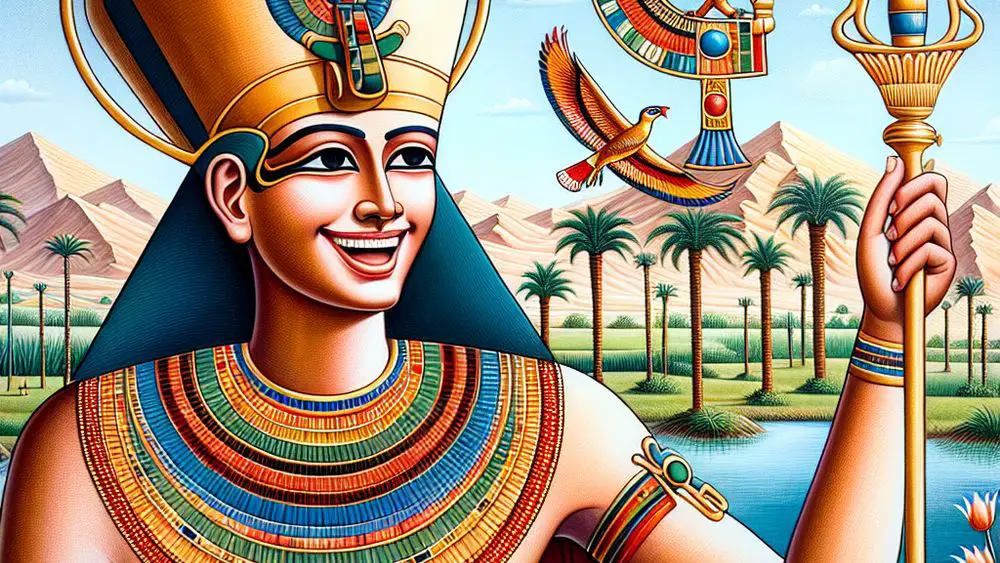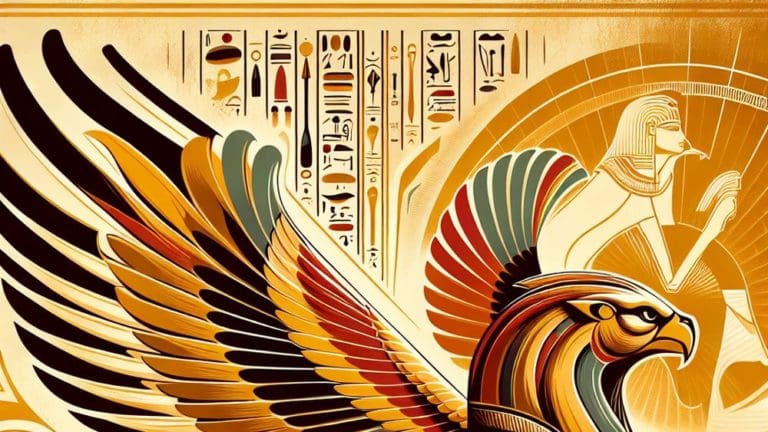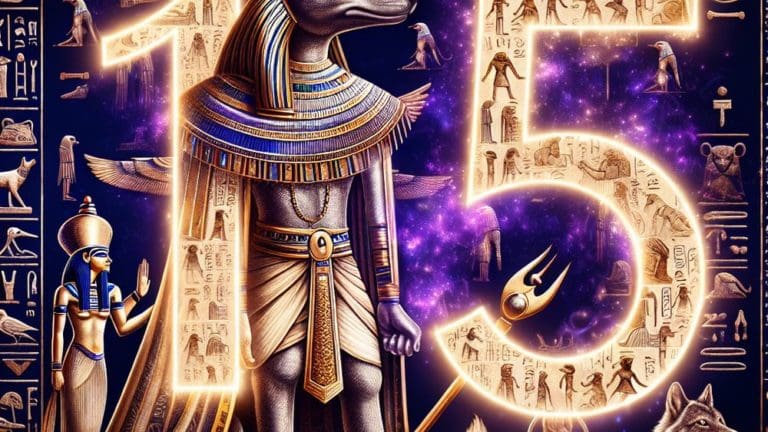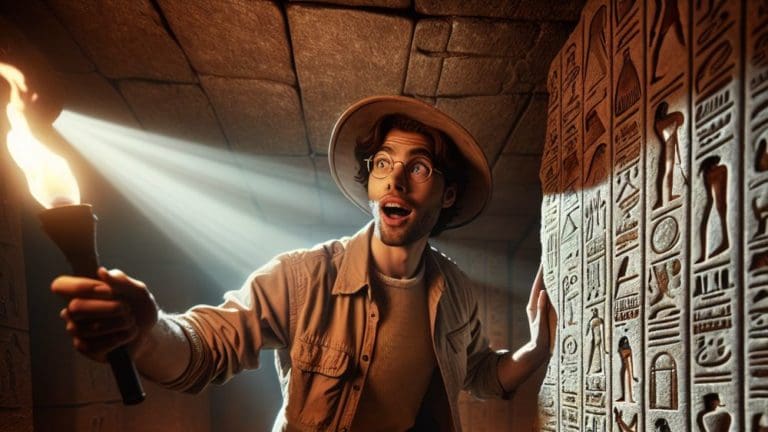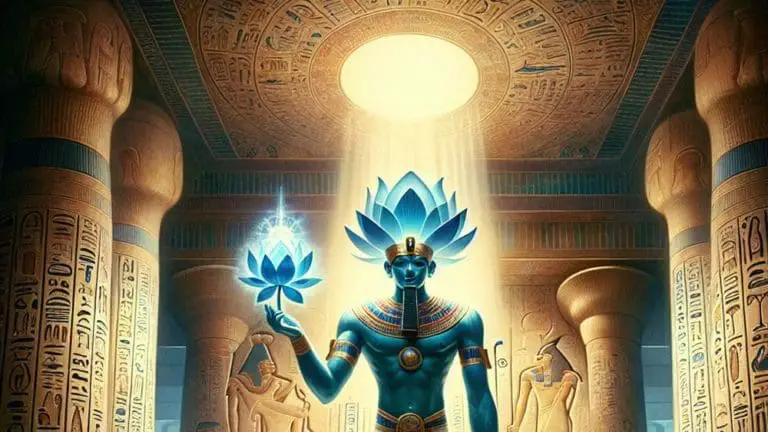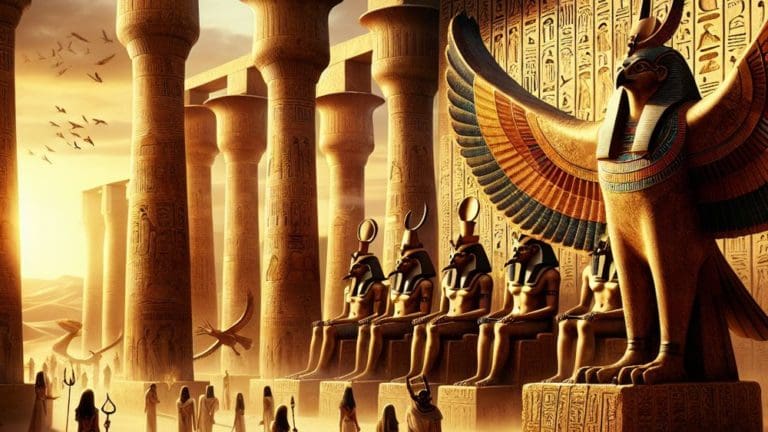Ihy: The Egyptian God Of Music And Joy
Ihy: The Egyptian God Of Music And Joy
Have you ever wondered about the lesser-known deities of Ancient Egypt, those who danced in the shadows of giants like Osiris and Anubis? Let’s turn the spotlight on the Egyptian god Ihy, a figure representing music and joy, whose melodies echoed through the sands of time, yet remains an enigma to many.
Key Points:
- Ihy is an Egyptian god of music and joy, son of Hathor and Horus.
- Symbols associated with Ihy include the sistrum, calf, and crown with the Hathoric disk.
- Ihy’s worship involved music, dance, and celebrations.
- Festivities dedicated to Ihy showcased the Egyptians’ love for music and dance.
- The sistrum was a key instrument in Ihy’s worship, believed to ward off evil spirits.
- Ihy’s role as a deity of joy and music was deeply embedded in Egyptian society.
- Depicted as a child or calf, Ihy symbolized renewal, vigor, and the joy of life.
Wrapped in the allure of mystery and ancient melodies, Ihy invites us to explore the corridors of history to uncover his story. His is a tale not just of mythological significance but of the cultural richesse that music and joy brought to the everyday lives of the Egyptians.
Unveiling Ihy: The Harmonious Deity of Ancient Egypt
Ihy, the son of Hathor, the goddess of motherhood, beauty, and love, and Horus, the god of kingship and the sky, embodies the joyous vibrations that music brings into the world.
The Mythological Origins of Ihy
Ihy’s origins are as intriguing as they are mythical, painting a picture of divine birth and celestial celebration.

- Son of Hathor and Horus: Born to two of the most venerated gods, Ihy’s arrival was heralded with music and dancing.
- Associated with Joy: From his first cry, Ihy was identified with happiness and mirth, blessing those around him with the pleasure of music and dance.
His mythological roots highlight the Egyptians’ deep connection to music and joy as fundamental elements of spiritual and daily life.
Embrace the essence of joy and music in your life, just like Ihy, the divine figure whose birth was celebrated with music and dancing, symbolizing the profound connection between music, happiness, and spiritual well-being.
Symbols and Iconography Associated with Ihy
The symbols and images associated with Ihy are rich in meaning, offering insights into his role and importance in Egyptian mythology and daily life.
- Sistrum: This musical instrument, emblematic of Ihy, was believed to ward off evil spirits and invoke his mother Hathor’s blessings.
- Calf: As a youthful deity, Ihy is often depicted as a calf, symbolizing renewal, vigor, and the joy of life.
- Crown with the Hathoric disk: Reflecting his direct lineage to Hathor, a crown adorned with cows’ horns and a sun disk underscores Ihy’s divine heritage and connection to music and joy.
These symbols offer a vivid portrayal of Ihy’s character and his esteemed position among the Egyptian gods.
The Musical and Joyful Aspects of Ihy’s Worship
The worship of Ihy was permeated with music and celebration, reflecting his essence as a deity of joy. His devotees brought music into their rituals to honor him, using instruments that were believed to invoke his spirit and favor.
Ihy’s Role in Music and Celebration in Ancient Egypt
In the vibrant lands of Ancient Egypt, Ihy played a pivotal role, invigorating the culture with music and joy. This revered deity, often depicted as a child, was a symbol of the pleasure and power music held in connecting people to the gods.
The musical and celebratory aspects of Ihy’s worship were deeply embedded in Egyptian society, where music was not just entertainment but a sacred connection to the divine. Festivities dedicated to Ihy were filled with song and dance, illustrating the significance of music in rituals and everyday life.
- Music was central to worship and celebrations.
- Dance and song facilitated connections with deities.
- Ihy symbolized the joy music brought into the lives of the Egyptians.
- Instruments like the sistrum were vital in ceremonies.
Music and dance were integral in Ancient Egyptian society, serving as sacred connections to the divine and bringing joy into people’s lives through the worship of the deity Ihy.
The Sacred Instruments of Ihy: Emphasizing the Sistrum
Ihy’s worship was closely associated with the sistrum, an instrument believed to ward off evil spirits and invoke the deity’s blessings. This sacred instrument was not only a testament to the musical heritage of Ancient Egypt but also a symbol of joy and protection.
| Instrument | Significance in Worship | Connection to Ihy |
|---|---|---|
| Sistrum | Evokes joy and wards off evil | Integral to Ihy’s rituals |
| Drums | Signals celebration | Used in festivities honoring Ihy |
| Harp | Represents harmony and balance | Celebrates Ihy’s connection to music |
| Flutes | Invokes the spirit of life | Symbolizes Ihy’s role in joy and pleasure |
Festivities and Rituals: How Ihy Was Honored
Ihy, as the son of Hathor, was celebrated with a myriad of festivities and rituals that showcased the Egyptians’ love for music and dance. The enthusiasm and reverence for Ihy were evident in the grandeur of the celebrations in his honor.
The ceremonies dedicated to Ihy were marked by joy and musical exuberance, reflecting the god’s essence of life and happiness. Participants experienced the divine connection through every beat, making these rituals a significant part of Egyptian culture.
- Music-filled processions celebrated Ihy’s role in Egyptian mythology.
- Dance performances highlighted the joy Ihy personified.
- Festivals emphasized Ihy’s connection to fertility, music, and joy.
- Sacred rituals involved the use of the sistrum to honor Ihy.
FAQs
1. How is Ihy depicted in ancient Egyptian art?
In ancient Egyptian art, Ihy is depicted as a young child or a calf, symbolizing his connection to music, joy, and birth. This depiction reinforces Ihy’s role as the god of music and highlights his importance in the culture and mythology of Ancient Egypt.
2. Can you explain the relationship between Ihy and Hathor?
The relationship between Ihy and Hathor is deeply entwined in Egyptian mythology. Ihy is celebrated as the child of Hathor, the goddess of music, dance, joy, and fertility. This connection portrays a familial bond that not only highlights Ihy’s significance in the realm of joy and music but also strengthens his mother’s attributes through his divine representation of celebration and musical ecstasy.
3. What is the significance of the sistrum in Ihy’s worship?
The significance of the sistrum in Ihy’s worship lies in its symbolic association with joy and music, core aspects of Ihy’s divine essence. This ancient musical instrument, deeply rooted in Egyptian culture, served as a medium to evoke Ihy’s blessings during religious festivities. Its enchanting sounds were believed to please the gods, beckoning Ihy’s favor and protection, fostering an atmosphere of harmony and divine pleasure among worshippers.
4. Are there any temples dedicated to Ihy?
When pondering whether there are temples dedicated to Ihy, it’s key to recognize that while Ihy might not be the primary deity of large temple complexes, evidence suggests smaller shrines and altars were dedicated to honor him, especially within the precincts of his mother, Hathor’s temples. Notably, the Dendera Temple complex, a homage to Hathor, features inscriptions and depictions celebrating Ihy’s essence, revealing his worship was intertwined within the religious spaces dedicated to his mother.
Conclusion
Exploring the enigmatic presence of the Egyptian god Ihy unearths a captivating blend of divine music, joy, and cultural reverence that continues to enchant history enthusiasts, musicians, and travelers alike. From the mythological tales highlighting his lineage and significance to the vibrant depictions in ancient Egyptian art, Ihy’s legacy is a testament to the profound depth of Egypt’s religious and cultural fabric. Whether through the rhythmic clattering of a sistrum or the joyous festivities in his honor, Ihy’s spirit invites us to appreciate the timeless melodies of the past, urging us to keep the rhythm of ancient mysteries alive in our hearts. Thank you for joining me on this melodic journey into the past; may your explorations be filled with as much joy and music as the celebrations of Ihy. Warmest regards, Cedric.

